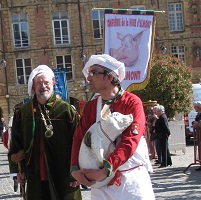
Charleville-Mézières’s major architectural attraction is its vast Place Ducale. I can well imagine hopping off a train, taking the 10-minute walk to this great square for a drink or meal, luxuriating in its expansive marriage of brick and stone, then returning to the station to pursue the journey to my destination, radiant with the sense that I’d made the right choice to prolong a travel day for such a pleasing pause. Rather, I would be able to imagine that if Charleville-Mézières were actually on the way someplace. But it isn’t, unless you’ve gotten lost on your way to Luxembourg, for if Charleville-Mézières isn’t your destination then it is highly unlikely to be on your route.
I’m glad then that I’d made it my destination — rather, part of my destination as I set out to explore the Ardennes area of France for a taste of local beer, local cuisine, local characters and local history — because entering the ducal square on a bright May day immediately opened my sense of the rewards of visiting this far-flung corner of France.
I also felt quite connected with the history of Paris, the city I’d left to rail this way, since the Place Ducale, begun in 1612, was designed by Clément Métezeau, brother of Louis Métezeau, who is attributed with the design of the Place des Vosges, begun in 1605, in the capital’s Marais district. With their regular repetition of brick and stone, with slate roofs and sidewalk arcades, the two squares have much common, though Charleville’s is more open and cosmopolitan. It was designed as the hub on a new town created by decree of Duke Charles de Gonzague, count of Rethel, whose family (the Gonzagas) came from Lombardy. Charles had a palace in Mézières, a strategic site of ancient origin nearby along the Meuse River. His was a border town, a small economic center between the Kingdom of France and the Holy Roman (Germanic) Empire, and Charles dreamt of creating within the nearby loop of the river an ideal city nearby, centered around a great square from which the town would radiate in straight lines, which were generally absent from earlier, medieval towns.
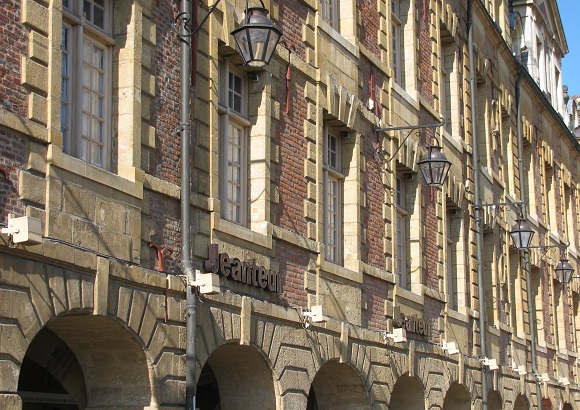
The “new and incomparable city,” as Charleville was soon called, would soon eclipse Mézières and neighboring towns as an economic powerhouse in the region. Three hundred fifty years later, in 1966, Charleville merged with four neighboring administrative districts, including Mézières, creating Charleville-Mézières.
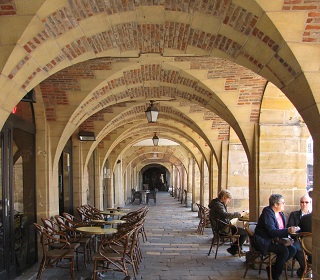
The tourist office is on the Place Ducale. With one’s hands full of maps and brochures, one naturally follows the sun when selecting a seat in a cafe or restaurant beneath or in front of the arcades of the square, whether to study the map or to watch the Carlomacériens, as local inhabitants are called, go by.
The French Ardennes may be beer country due to its lack of vineyards and its affinity with Belgium, but a traveler can feel guilty traveling in France and ignoring wine. We’re in a region called Champagne-Ardenne, a rather schizophrenic name that, brandwise, now sounds to me like Wine-Beer. One of the town’s main call of ports for wine is Eric Arnaud’s wine bar Le Concept, in the southeast corner of the square.
Arnaud is originally from Reims, meaning from champagne country. He worked as a chef while refining his wine knowledge and is now the only master sommelier in Ardennes as well as president of Champagne-Ardenne’s regional division of a French national sommelier association called the Union de la Sommellerie Française. In 2011 he opened Le Concept, an easy-going lunch- and dinner-serving wine bar, on the Place Ducale. Though removed from the setting and stature of the kitchen that he once oversaw in Reims, the food is fine that Arnaud prepares in a narrow kitchen space behind the bar counter, but the wine’s the thing.
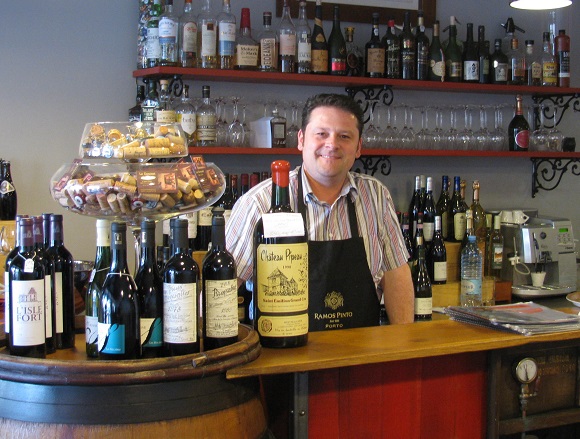
At aperitif time a plate of Ardennais cheese and/or cold cuts must be nice, but I’d come for lunch. Curious about cacasse, a traditional Ardennais potato-and-onion casserole with a roux of flour and lard, that’s what I ordered. The dish comes in two main versions, the cascasse à cul-nu, literally the “bare-ass” version, and cacasse culottée, literally the “knickered” version. There’s a veritable cult to cacasse à cul-nu in the Ardennes, in part, I found, because people simple enjoy saying the term, which sounds both slightly childish and slightly offensive (cul=ass, nu=naked, caca=caca). But above all, in a region relatively poor in culinary offerings (some cheese, some cold cuts, some sausages, lots of potatoes) it’s roots go deep. As with many local dishes in France, cacasse has peasant origins and has earned over time a strong cultural power on all lines of the economic spectrum. With enough means on a given day a family might have been able to add sausage or bacon to their cacasse, thereby dressing it with meat. The version I relished for lunch was clothed with thickly sliced bacon (lardons).
It was hearty, tasty and might have been well accompanied by beer, but here I was in a wine bar. Since the Ardennes is without vineyards, one is obliged to travel for a wine choice, and leaving my fate in Mr. Arnaud’s hand he returned with a caramel-colored red from the Jura, near Switzerland, an Arbois Poulsard “Grande Réserve” 2005, a fruity wine of lesser-known terroir that’s fine to share with a friend. And as I was sitting there, one showed up.
A new friend, that is: Bernard Giraud, journalist with the regional paper L’Ardennais and great “defender of the products and recipes of terrior and conviviality,” to quote the man. Giraud lives in Sedan, just to the north (see Part 3 of this article). In 1991, he told me, following his own admission to a fraternal order of Belgian beer lovers, Giraud began to see the interest and pleasure of defending local gastronomic heritage wherever its homeland may be. He is now a member or brother or knight in 16 different fraternal orders.
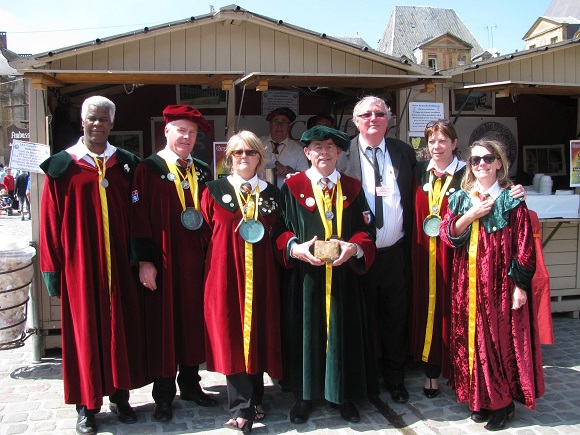
In 2004 Giraud created Ch-M’s Festival des Confréries, an annual celebration of such brotherhoods (sisters welcome). This joyful, convivial event takes places over a weekend in early May, which happened to be when I was visiting. At first glance it might appear that you have to be fond of tripe and lard and rabbit cooked in beer to appreciate the festival, but the true pleasure of the event is taking part in the human hokiness of meeting French, Belgian and Ardennais ambassadors of traditional gastronomy who are so passionate about such dishes that they’re willing to travel to Charleville-Mézières and don colorful velvet robes and floppy hats to prove it.
Giraud is also the vice president of the French Counsel of such Fraternal Orders (Conseil Français des Confréries), an organization created in 2006 in Orléans, in the Loire Valley. According to Giraud, there are about 700 confréries in France, about half of which belong to the Counsel. Confréries were corporations in the Middle Ages, and again that corporative (meaning business) spirit is still clearly visible in the large wine confréries (one of the most famous is the Conférie des Chevaliers du Tastevin in Burgundy). Though some confréries have strong ties with producers, particularly in the wine sector, and thus actively promote their products beyond the locality, most of the gastronomic brotherhoods simply maintain the tradition of local cuisine against changing eating habits. In any case, where there’s a confrérie there is hearty, well-fed, well-imbibed fun, and Charleville-Mézières’s Festival des Confréries honors the concept with good humor, simplicity and lots of cacasse.
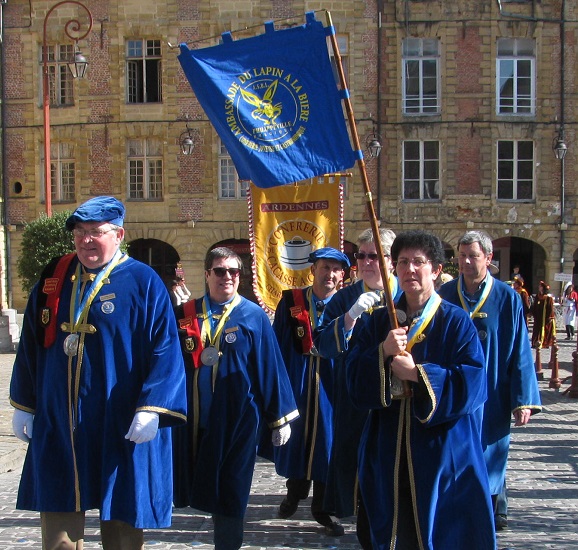
It’s rare to see someone under 50 years old wearing one of these robes. It’s the type of local tradition in France that Arthur Rimbaud would have fled, but one man’s flight is another man’s arrival. I saw it as a fun, family event, with each association manning a booth where one can learn about, taste and purchase their products, from rabbit in beer to rabbit pate, from tripe to black pudding, from nougat to dandelion dishes. There’s quite naturally a brotherhood of cacasse à cul-nu lovers. Under the food tent on the square for the celebration there was a monster-size party dish of that naked local favorite, with knickers available on the side.
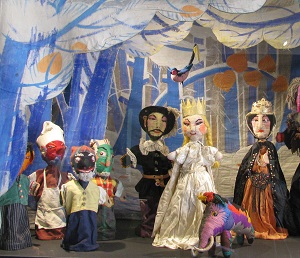 Charleville-Mézières has a more joyful, magical and renowned festival, one that celebrates marionette theater. Marionettes, rather than gastronomic brotherhoods, are actually the city’s great contemporary call to fame. Every two years in September (next time: Sept. 18-27, 2015), the World Festival of Marionette Theaters draws 150,000 spectators to venues both inside and outside. The National School of the Marionette Arts is here as well as the headquarters of the International Marionette Union, a resource center for marionette practitioners. Around the corner from the Place Ducale, an automat called The Great Marionettist marks the hour daily from 10am to 9pm with a dozen tableaux.
Charleville-Mézières has a more joyful, magical and renowned festival, one that celebrates marionette theater. Marionettes, rather than gastronomic brotherhoods, are actually the city’s great contemporary call to fame. Every two years in September (next time: Sept. 18-27, 2015), the World Festival of Marionette Theaters draws 150,000 spectators to venues both inside and outside. The National School of the Marionette Arts is here as well as the headquarters of the International Marionette Union, a resource center for marionette practitioners. Around the corner from the Place Ducale, an automat called The Great Marionettist marks the hour daily from 10am to 9pm with a dozen tableaux.
In a moment of nostalgia during the day I had bought a post card, an object as old fashion as cacasse and rabbit pate, to mail across the ocean. The post office, I saw on the map, was a few blocks away, a slight detour on my way back to the hotel for a pre-Mawhot rest. Across the street from the post office was a café and beer bar, Le Vert Bock. I could have used the café more than the beer, but I wanted to end the afternoon on a headier note in keeping with my quest. So I went in, ordered a glass from a tap with a name I didn’t know, and voilà, another bar, if not beer, that I can now recommend on the beer trails of the Ardennes.
© 2014, Gary Lee Kraut
Continue to The French Ardennes, Part 3: The Meuse, Sedan, More Beer and the Big Boar
Return to The French Ardennes, Part 1: Charleville-Mézières: The Runaway Poet, Great Beer Bars and the Giant Lizard
Addresses and other information, in order of appearance in this article
Charleville-Mézières Tourist Office
4 Place Ducale
08102 Charleville-Mézières
Tel. 03 24 55 69 90
Open Mon.-Sat. 9:30am-12:00pm and 1:30-6:00pm, until 7pm in summer. Also open Sunday in summer.
www.charleville-mezieres.org/indexpc.php
Le Concept (Eric Arnaud)
37, place Ducale
08000 Charleville-Mézières
Tel.: 03 24 22 57 03
Open Wed.-Sat. noon-2pm and 6:30pm on through the evening, also Tues. evening.
Festival des Confréries, held annually in early May.
World Festival of Marionette Theaters, held in Charleville-Mézières every two years in September. Next time: Sept. 18-27, 2015.
Le Vert Bock
20 rue du Théâtre
08000 Charleville-Mézières
Tel. 03 24 35 06 64
Open Tues.-Fri. 8am-9pm, Sat. 9 :30am-9pm
Hôtel Le Dormeur du Val (Best Western)
32 bis rue de la Gravière 08000 Charleville Mézières Tél. : 03 24 420 430
www.hotel-dormeur-du-val.com
My hotel during this 2-night, 3-day visit to the Ardennes was the Hôtel Le Dormeur du Val, 150 yards up the tracks from the train station. It’s a friendly place with a playful semi-industrial design, sometimes successful (the bathroom), sometimes not (the reading light poking you in the head). The street itself is quite though occasionally you can hear the SNCF rail company’s 3-tone intro and an announcement from the train station: Le train en provenance de Sedan et en destination de Champagne-Ardenne rentre en gare, voie une. The hotel, 4-star by category and 3-star by spirit, is convenient for those arriving by train and remaining for a night or two, as I did. I enjoyed the quirkiness and convenience of the hotel. From here, as from the train station, it’s a 10-minute walk to the Place Ducale, which is the heart of the town.

